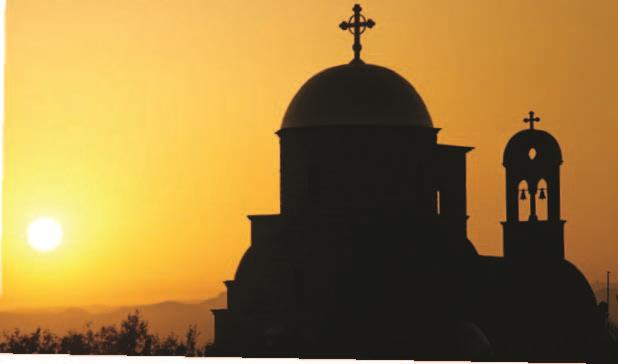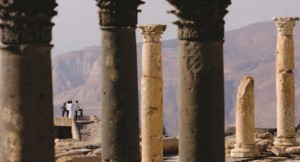Ideal for faith-based groups, this small country packs a big punch.
Have you visited the Holy Land? Did it include the Kingdom of Jordan? If not, you did not have the full Holy Land experience. Consider a return visit for the rest of the story
My personal travels have taken me to many areas full of Biblical history, both Old and New Testament sites, some multiple times, but my experience was not complete until a visit to Jordan last fall.
The visit was during a period of upheaval in the Muslim world, and some travelers had concerns about safety. But our trip was without incident. Yes, I did see a protest in Amman, the capital, and was quick to tell everyone about it when asked on my return if there were any protests or riots. The protest was a group of senior citizens on lawn chairs demanding higher retirement payments from the government. Obviously, no threat to safety.
The people of Jordan are friendly and family-oriented, looking to give their families the kind of good life that everyone wants. One day our bus was parked along a street to visit the USAID Center for Women, a shop/studio where pottery-making is taught. We waited for the last members of our group to come back to the bus when some children walked by. One woman in our group shared a candy bar with the children, breaking it into small pieces for everyone. The boys wanted their pictures taken with the “nice lady.” An older gentleman in Arab dress walked by and stopped to make sure the boys were not being a nuisance. “No, no we love to see them” was the general reply. The man extended to all of us on the bus an invitation to come to his house for tea—an example of Jordanian hospitality.
Jordan is a land of prophets, miracles, apostles, priests and wanderers. Travelers today follow in the footsteps of Abraham, Moses, Job, Ruth, Elijah, John the Baptist, Jesus, Paul and others who traveled there. Sites on a faith-based group itinerary would include:
Bethany Beyond the Jordan. See the cave where John the Baptist lived and carried out his work. This is the site of Jesus’ baptism by John the Baptist. Here Jesus started his public ministry at the age of 30. Matthew 3:16-17, New International Version (NIV): “As soon as Jesus was baptized, he went up out of the water. At that moment heaven was opened, and he saw the Spirit of God descending like a dove and alighting on him. And a voice from heaven said, ‘This is my Son, whom I love; with him I am well pleased.’”
Old Testament Medeba (modern day Madaba). The “City of Mosaics” is home to ancient floor mosaics in several churches. The region is referenced in the Old Testament during the life of Moses and the Exodus, David’s war with the Moabites.
Mount Nebo/Pisgah. A church on this mountaintop marks the site of Moses’ death. Take in the panoramic views of the Jordan River Valley and Dead Sea. This is a place to allow your group time for meditation. You will feel personal emotion as you ponder Moses in this place. Deuteronomy 34:1, NIV: “Then Moses climbed Mount Nebo from the plains of Moab to the top of Pisgah, across from Jericho. There the Lord showed him the whole land—from Gilead to Dan.”
Machaerus (modern day Mukawir). This is the place where Herod imprisoned and beheaded John the Baptist. (Matthew 14:3-11)
Gadara (modern day Umm Quais). Great ruins and vistas highlight this old Decapolis city that overlooks the Sea of Galilee. It is where Jesus performed the miracle of chasing the Gadarene swine down the hill and into the waters of the Sea of Galilee. (Matthew 8:28-34)
Gerasa (modern day Jerash). The Bible does not mention Gerasa by name, but it was one of the Decapolis cities (Jordan has six of the 10 ancient cities). A must-see, it is one of the most completely preserved cities of the ancient Greco-Roman world.
Elath (modern day Aqaba). Today a modern Red Sea port and beach resort, this Southern Jordan city is mentioned in the Exodus as Ezion-geber (Elath). (Numbers 33:35). The area is also associated with King Solomon and the kings of Judah and Edom. (Deuteronomy 2:8, I Kings 9:26 and II Kings 14:22).
Amman. The capital city is a delight to visit. The people are friendly and it is easy to get around. Lodging choices range from good 3-star hotels to luxury 5-star hotels. Biblical Amman is Rabath Ammon and is referenced in Deuteronomy and the history of King Og, a “giant of a Man.” The Citadel, a hilltop archeological museum, is a treasure chest of ancient artifacts and ruins from the Roman and Byzantine period.
The Kings’ Highway. You will travel this road during your visit to Jordan and it has some spectacular scenery, sunrise to sunset. The first mention of the roadway is from Numbers 20:17. The Kings’ Highway is the world’s oldest continuously used communication route. It used to link ancient Bashan, Giliad and Ammon in the north with Moab, Edom, Paran and Midian in the south.
Petra. Designated as one of the New Seven Wonders of the World, the “Lost City” of Petra may have been listed by a different name in the Bible, but today this archaeological site is on the bucket lists of many travelers and the signature sight in Jordan. Biblical history includes Old Testament kings, Moses and the Israelites, Aaron (brother of Moses) and the kings of the nativity with their gifts of gold, frankincense and myrrh. The “rose red city” of Petra is a full-day adventure for faith-based pilgrims and adventurous travelers.
In the adjacent modern town of Wadi Musa, the Petra Kitchen offers a special dining experience. Your group will prepare dinner with travelers from around the world with the guidance of the local staff. Everyone is divided by tables to make the evening meal. My group made a yogurt cucumber dill dip. Other tables made soup, the main entrée, appetizers and dessert.
Wadi Rum – Desert Majesty. Wadi Rum in Southern Jordan is a journey to another world. A vast, silent place, timeless and starkly beautiful, Wadi Rum is one of the world’s most stunning landscapes and epitomizes the romance of the desert. Now the home of several Bedouin tribes, Wadi Rum has been inhabited for generations. These friendly desert people live in scattered nomadic camps. Visitors who are invited to share mint tea or cardamon coffee in their black goat-hair tents, or perhaps by the fire under a starry desert sky, will have an unforgettable experience.
My travel group spent the night in the desert under the watchful care of several Bedouins. We dined on a delicious dinner of meat, potatoes and vegetables cooked underground in a metal container with shelves for each part of the meal. Buried in sand atop glowing coals, it’s the ancient version of our crock pots. Overnight accommodations were black tents with cots and soft lighting (candles stuck in small cans with sand for support). Some of the group fell asleep under the stars as the last glow of the campfire faded.
Wadi Rum is best known for its connection with the enigmatic British officer T.E. Lawrence, who was based there during the Great Arab Revolt of 1917-18, and as the setting for the 1962 film Lawrence of Arabia.
Dead Sea Resorts. A resort visit on the eastern shore of the Dead Sea provides a relaxing break from touring archaeological sites and religious shrines. At 1,312 feet below sea level, the Dead Sea (actually a lake) is the lowest spot on earth. Beach-goers float effortlessly in the buoyant, mineral-rich water, and many take a therapeutic mud bath with the oily black mud gathered from the sea floor.
Luxury resorts with lushly landscaped courtyards offer freshwater swimming pools, a wide choice of restaurants, and spa treatments and therapies using products derived from the sea. The Dead Sea, about an hour from Amman, is near many places mentioned in the Bible. From the Dead Sea Highway, tour guides point out a dried pillar of salt said to be the remains of Lot’s wife (who was turned into a pillar of salt for disobeying God’s will).
All too often church travel groups will visit Israel and think they’ve seen all of the Holy Land, but Jordan obviously abounds with treasures and offers many opportunities for spiritual insight and renewal. Itineraries also can incorporate Middle Eastern culture, adventure and sport, relaxation, and health and wellness.
Jordan easily can be a stand-alone destination worth seven or eight days. If you visit for only a day or two, you will miss so much of what Jordan has to offer.
For tour planning tips, visit www.myjordanjourney.com
By Cindi Brodhecker









